ZHCS599B December 2011 – August 2015 TPS7A8101
PRODUCTION DATA.
6 Specifications
6.1 Absolute Maximum Ratings
Over operating free-air temperature range (unless otherwise noted).(1)| MIN | MAX | UNIT | ||
|---|---|---|---|---|
| Voltage | IN | –0.3 | 7 | V |
| FB, NR | –0.3 | 3.6 | ||
| EN | –0.3 | VIN + 0.3(2) | ||
| OUT | –0.3 | 7 | ||
| Current | OUT | Internally Limited | A | |
| Temperature | Operating virtual junction, TJ | –55 | 150 | °C |
| Storage, Tstg | –55 | 150 | °C | |
(1) Stresses beyond those listed under Absolute Maximum Ratings may cause permanent damage to the device. These are stress ratings only, and functional operation of the device at these or any other conditions beyond those indicated is not implied. Exposure to absolute-maximum-rated conditions for extended periods my affect device reliability.
(2) VEN absolute maximum rating is VIN + 0.3 V or +7 V, whichever is smaller.
6.2 ESD Ratings
| VALUE | UNIT | ||||
|---|---|---|---|---|---|
| V(ESD) | Electrostatic discharge | Human body model (HBM), per ANSI/ESDA/JEDEC JS-001, all pins(1) | ±2000 | V | |
| Charged device model (CDM), per JEDEC specification JESD22-C101, all pins(2) | ±500 | ||||
(1) JEDEC document JEP155 states that 500-V HBM allows safe manufacturing with a standard ESD control process.
(2) JEDEC document JEP157 states that 250-V CDM allows safe manufacturing with a standard ESD control process.
6.3 Recommended Operating Conditions
Over operating free-air temperature range (unless otherwise noted)| MIN | MAX | UNIT | ||
|---|---|---|---|---|
| VI | Input voltage | 2.2 | 6.5 | V |
| IO | Output current | 0 | 1 | A |
| TA | Operating free air temperature | –40 | 125 | °C |
6.4 Thermal Information
| THERMAL METRIC(1) | TPS7A8101 | UNIT | |
|---|---|---|---|
| DRV (SON) | |||
| 8 PINS | |||
| RθJA | Junction-to-ambient thermal resistance | 47.8 | °C/W |
| RθJC(top) | Junction-to-case (top) thermal resistance | 53.9 | °C/W |
| RθJB | Junction-to-board thermal resistance | 23.4 | °C/W |
| ψJT | Junction-to-top characterization parameter | 1 | °C/W |
| ψJB | Junction-to-board characterization parameter | 23.5 | °C/W |
| RθJC(bot) | Junction-to-case (bottom) thermal resistance | 7.4 | °C/W |
(1) For more information about traditional and new thermal metrics, see the Semiconductor and IC Package Thermal Metrics application report, SPRA953.
6.5 Electrical Characteristics
Over the operating temperature range of TJ = –40°C to +125°C, VIN = VOUT(TYP) + 0.5 V or 2.2 V (whichever is greater), IOUT = 1 mA, VEN = 2.2 V, COUT = 4.7 μF, CNR = 0.01 μF, and CBYPASS = 0 μF, unless otherwise noted. TPS7A8101 is tested at VOUT = 0.8 V and VOUT = 6 V. Typical values are at TJ = 25°C.| PARAMETER | TEST CONDITIONS | MIN | TYP | MAX | UNIT | |||
|---|---|---|---|---|---|---|---|---|
| VIN | Input voltage range(1) | 2.2 | 6.5 | V | ||||
| VNR | Internal reference | 0.79 | 0.8 | 0.81 | V | |||
| VOUT | Output voltage range | 0.8 | 6 | V | ||||
| Output accuracy(2) | VOUT + 0.5 V ≤ VIN ≤ 6 V, VIN ≥ 2.5 V, 100 mA ≤ IOUT ≤ 500 mA, 0°C ≤ TJ ≤ 85°C |
-2% | 2% | |||||
| VOUT + 0.5 V ≤ VIN ≤ 6.5 V, VIN ≥ 2.2 V, 100 mA ≤ IOUT ≤ 1 A |
–3% | ±0.3% | 3% | |||||
| ΔVO(ΔVI) | Line regulation | VOUT(NOM) + 0.5 V ≤ VIN ≤ 6.5 V, VIN ≥ 2.2 V, IOUT = 100 mA |
150 | μV/V | ||||
| ΔVO(ΔIL) | Load regulation | 100 mA ≤ IOUT ≤ 1 A | 2 | μV/mA | ||||
| VDO | Dropout voltage(3) | VOUT + 0.5 V ≤ VIN ≤ 6.5 V, VIN ≥ 2.2 V, IOUT = 500 mA, VFB = GND or VSNS = GND |
250 | mV | ||||
| VOUT + 0.5 V ≤ VIN ≤ 6.5 V, VIN ≥ 2.5 V, IOUT = 750 mA, VFB = GND or VSNS = GND |
350 | |||||||
| VOUT + 0.5 V ≤ VIN ≤ 6.5 V, VIN ≥ 2.5 V, IOUT = 1 A, VFB = GND or VSNS = GND |
500 | |||||||
| ILIM | Output current limit | VOUT = 0.85 × VOUT(NOM), VIN ≥ 3.3 V | 1100 | 1400 | 2000 | mA | ||
| IGND | Ground pin current | IOUT = 1 mA | 60 | 100 | μA | |||
| IOUT = 1 A | 350 | |||||||
| ISHDN | Shutdown current (IGND) | VEN ≤ 0.4 V, VIN ≥ 2.2 V, RL = 1 kΩ, 0°C ≤ TJ ≤ 85°C |
0.2 | 2 | μA | |||
| IFB | Feedback pin current | VIN = 6.5 V, VFB = 0.8 V | 0.02 | 1 | μA | |||
| PSRR | Power-supply rejection ratio | VIN = 4.3 V, VOUT = 3.3 V, IOUT = 750 mA |
f = 100 Hz | 80 | dB | |||
| f = 1 kHz | 82 | |||||||
| f = 10 kHz | 78 | |||||||
| f = 100 kHz | 60 | |||||||
| f = 1 MHz | 54 | |||||||
| Vn | Output noise voltage | BW = 100 Hz to 100 kHz, VIN = 3.8 V, VOUT = 3.3 V, IOUT = 100 mA, CNR = CBYPASS = 470 nF |
23.5 | μVRMS | ||||
| VEN(HI) | Enable high (enabled) | 2.2 V ≤ VIN ≤ 3.6 V, RL = 1 kΩ | 1.2 | V | ||||
| 3.6 V < VIN ≤ 6.5 V, RL = 1 kΩ | 1.35 | |||||||
| VEN(LO) | Enable low (shutdown) | RL = 1 kΩ | 0 | 0.4 | V | |||
| IEN(HI) | Enable pin current, enabled | VIN = VEN = 6.5 V | 0.02 | 1 | μA | |||
| tSTR | Start-up time | VOUT(NOM) = 3.3 V, VOUT = 0% to 90% VOUT(NOM), RL = 3.3 kΩ, COUT = 10 μF, CNR = 470 nF |
80 | ms | ||||
| UVLO | Undervoltage lockout | VIN rising, RL = 1 kΩ | 1.86 | 2 | 2.10 | V | ||
| Hysteresis | VIN falling, RL = 1 kΩ | 75 | mV | |||||
| TSD | Thermal shutdown temperature | Shutdown, temperature increasing | 160 | °C | ||||
| Reset, temperature decreasing | 140 | °C | ||||||
| TJ | Operating junction temperature | –40 | 125 | °C | ||||
(1) Minimum VIN = VOUT + VDO or 2.2 V, whichever is greater.
(2) The TPS7A8101 does not include external resistor tolerances and it is not tested at this condition: VOUT = 0.8 V, 4.5V ≤ VIN ≤ 6.5 V, and 750 mA ≤ IOUT ≤ 1 A because the power dissipation is greater than the maximum rating of the package.
(3) VDO is not measured for fixed output voltage devices with VOUT < 1.7 V because minimum VIN = 2.2 V.
6.6 Typical Characteristics
At VOnom = 3.3 V, VI = VOnom + 0.5 V or 2.2 V (whichever is greater), IO = 100 mA, V(EN) = VI, C(IN) = 1 μF, C(OUT) = 4.7 μF, and C(NR) = 0.01 μF; all temperature values refer to TJ, unless otherwise noted.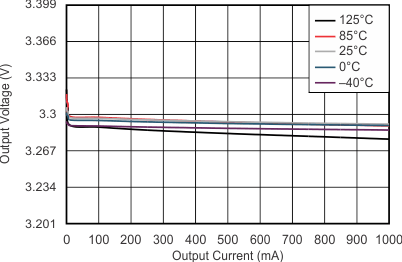
| NOTE: The Y-axis shows 1% VO per division | ||
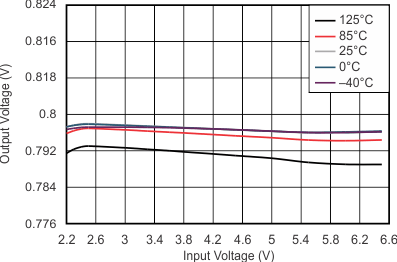
| VO = 0.8 V | IO = 750 mA | |
| NOTE: The Y-axis shows 1% VO per division | ||

| IO = 1 A | ||
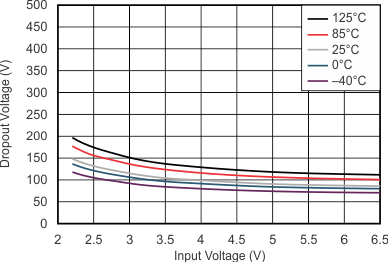
| IO = 500 mA | ||

| VI = 3.6 V | ||
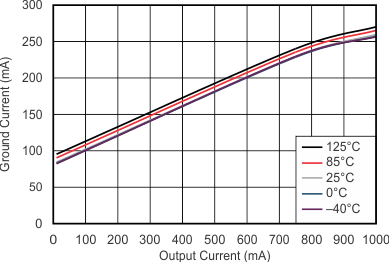

| VO = VI – 0.5 V |
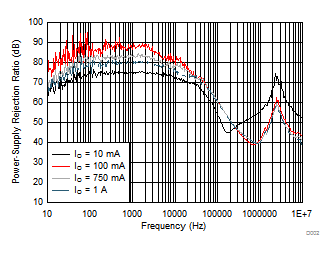
| VI – VO = 1 V | C(IN) = 0 F | C(OUT) = 10 µF |
| C(NR) = C(BYPASS) = 470 nF | ||
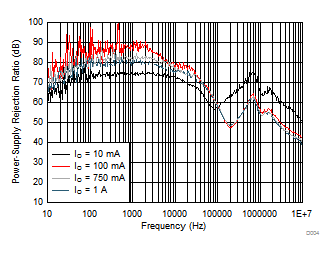
| VI – VO = 1 V | C(IN) = 0 F | C(OUT) = 10 µF |
| C(NR) = C(BYPASS) = 470 nF | ||
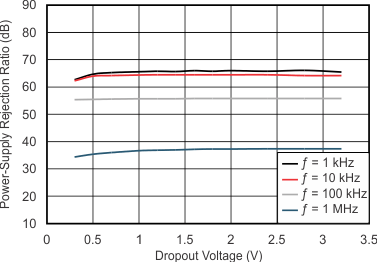
| IO = 100 mA | C(IN) = 0 F |
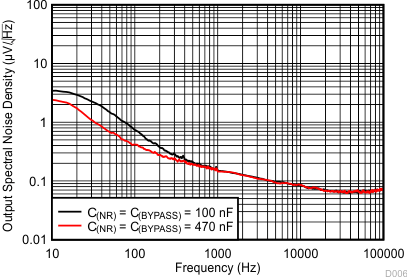
| VI – VO = 0.5 V | C(OUT) = 10 µF | C(IN) = 10 µF | |
| 24.09 µVRMS (C(NR) = C(BYPASS) = 100 nF) | |||
| 23.54 µVRMS (C(NR) = C(BYPASS) = 470 nF) | |||
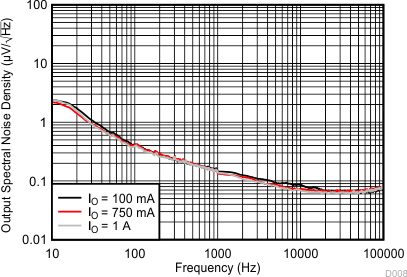
| 23.54 µVRMS (IO = 100 mA) | C(IN) = 10 µF | VI – VO = 0.5 V |
| 23.71 µVRMS (IO = 750 mA) | C(NR) = 470 nF | C(OUT) = 10 µF |
| 22.78 µVRMS (IO = 1 A) | C(BYPASS) = 470 nF | |

| Using the same value of C(NR) and C(BYPASS) in the X-Axis |

| IO = 100 mA → 1 A → 100 mA | ||
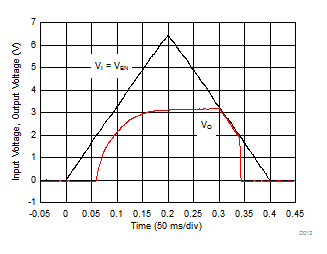
| RL = 33 Ω | C(NR) = 470 nF | C(BYPASS) = 470 nF | ||
| C(OUT) = 10 µF | C(IN) = 10 µF | |||
| (1) The internal reference requires approximately 80 ms of rampup time (see Start-Up) from the enable event; therefore, VO fully reaches the target output voltage of 3.3 V in 80 ms from start-up. | ||||

| NOTE: The Y-axis shows 1% VO per division | ||

| VO = 0.8 V | IO = 5 mA | |
| NOTE: The Y-axis shows 1% VO per division | ||
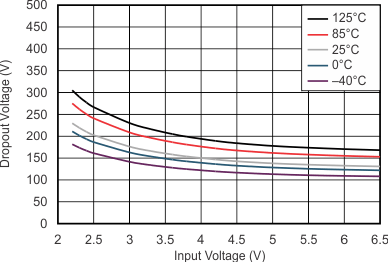
| IO = 750 mA | ||
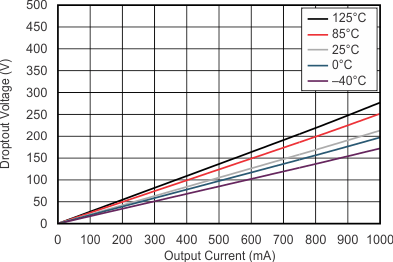
| VI = 3.6 V | ||
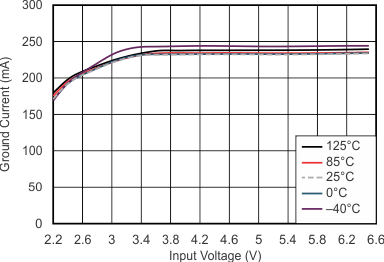
| VO = 0.8 V | IO = 750 mA | |
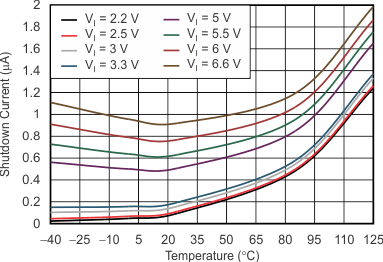
| V(EN) = 0.4 V | ||
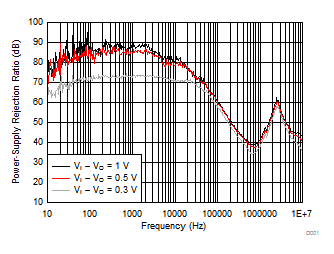
| C(NR) = C(BYPASS) = 470 nF | C(OUT) = 10 µF | C(IN) = 0 F |
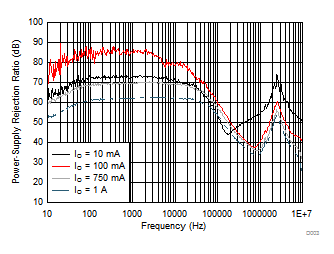
| VI – VO = 0.5 V | C(IN) = 0 F | C(OUT) = 10 µF |
| C(NR) = C(BYPASS) = 470 nF | ||
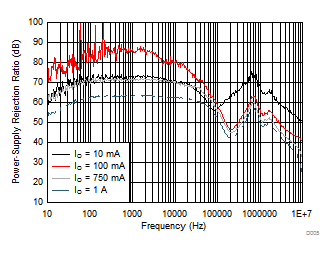
| VI – VO = 0.5 V | C(IN) = 0 F | C(OUT) = 10 µF |
| C(NR) = C(BYPASS) = 470 nF | ||
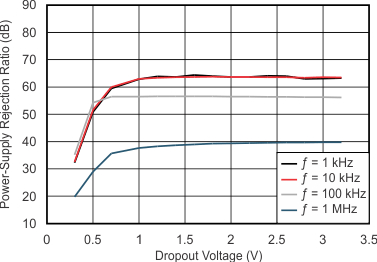
| IO = 750 mA | C(IN) = 0 F |
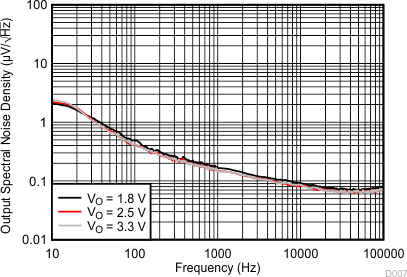
| 25.89 µVRMS (VO = 1.8 V) | C(IN) = 10 µF | VI – VO = 0.5 V |
| 23.54 µVRMS (VO = 2.5 V) | C(NR) = 470 nF | C(OUT) = 10 µF |
| 23.54 µVRMS (VO = 3.3 V) | C(BYPASS) = 470 nF | |

| 23.54 µVRMS (CO = 10 µF) | C(IN) = 10 µF | VI – VO = 0.5 V |
| 23.91 µVRMS (CO = 22 µF) | C(NR) = 470 nF | C(OUT) = 10 µF |
| 22.78 µVRMS (CO = 100 µF) | C(BYPASS) = 470 nF | |
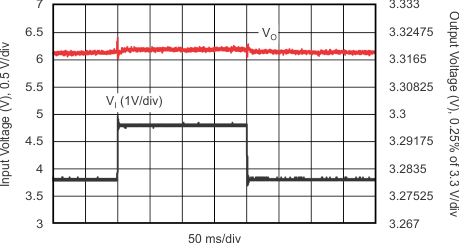
| VI = 3.8 V → 4.8 V → 3.8 V | ||
| IO = 500 mA | ||

| RL = 33 Ω | C(NR) = 470 nF | C(BYPASS) = 470 nF |
| C(OUT) = 10 µF | C(IN) = 10 µF |